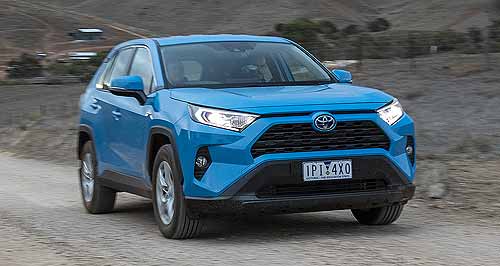Make / Model Search
News - Market Insight - Market Insight 2020Market Insight: Toyota increases market shareUpward shift: Models line the Corolla (left) and RAV4 (below) hybrid have helped Toyota increase its market share in 2020. Declining auto sales and more rivals fails to dampen Toyota in viral marketGallery Click to see larger images 23 Nov 2020 By NEIL DOWLING RELIABLE brand names that have weathered previous economic storms have been shaken as Australia closes in on three years of slumping car sales.
Even the bellwether Toyota brand hasn’t been unaffected. Its sales are down 7.8 per cent year-to-date in a market that is down 18.8 per cent but although its sales numbers are sliding, its market share has jumped almost three percentage points.
According to VFacts sales figures, to the end of October Toyota has a market share of 21.8 per cent from 51 brands (excluding Tesla) which is up from 19.2 per cent in the same time last year.
In the month of October, Toyota recorded a share of 24 per cent, up from 20.6 per cent in October 2019.
At the same time, in the 10 months of this year compared with 2019, it sold 13,376 fewer vehicles.
How does it do it? First, the majority of its competitors took a bigger sales dive leaving more of the shrinking pie to Toyota. There were 163,983 fewer passenger cars, light commercials and SUVs sold this year to October than in the same period in 2019.
Toyota mopped up sales from brands that slid, including Mazda (down 20.4 per cent YTD), Hyundai (down 30.8%), Mitsubishi (down 33.0%) and Volkswagen (down 22.0%).
These rivals, which sell similar product lines to Toyota, saw market shares fall. Mazda is down 0.19 percentage points to 9.4 per cent; Hyundai is down 1.22 percentage points to 7.0 per cent; Mitsubishi fell 1.35 percentage points to 6.4 per cent; and Volkswagen shed 0.19 percentage points to a share of 4.5 per cent.
Other losers included Honda – down 0.84 percentage points to 3.3 per cent of the market for the year to date, and Subaru, down 0.38 percentage points to a share of 3.4 per cent.
As the market absorbed and compensated for the exit of Holden, some brands also benefited in line with Toyota. Kia is up 0.58 percentage points to a share of 6.3 per cent, and Ford is up 0.44 percentage points to 6.4 per cent.
Secondly, Toyota has been through a model refresh and introduced niche variants including the hi-po Yaris GR and baby crossover, the Yaris Cross; the Supra coupe; new-gen Hiace and Tarago replacement Granvia; and powerhouse hybrid models led by the RAV4 and Corolla.
Then there’s the fleet market. Toyota has continued to benefit from the ongoing mining industry, with HiLux, LandCruiser, HiAce van and Coaster models all strong this year as fleets build their inventory.
The introduction of the Yaris Cross shows Toyota is willing to search for niches to build customers. It is a similar move that’s been followed for years by companies such as Audi and Mercedes-Benz.
Volkswagen also likes the concept, with its T-Cross and T-Roc crossover styles giving choice to buyers that may have entered the showroom after a Polo or Golf. Toyota similarly puts its Yaris Cross against the Yaris hatch and the C-HR SUV and RAV4 against the Corolla and Camry.
RAV4 sales, driven largely by the hybrid variant, are up 58.1 per cent year-to-date and a whopping 91.6 per cent for October, compared with October 2019.
Hybrids are also keeping Toyota’s flame bright. Aside from the stunning sales effect of the RAV4 Hybrid – with six hybrids in the 12-model range – which pushed waiting lists out to six months, success is also being seen with the four hybrid versions of the Corolla; three hybrid Camry variants; two in the Yaris hatch sector; and six hybrid lines in the nine-grade Yaris Cross.
It also did well with the Supra but eager buyers have since completed their orders and the model has fallen back to 20 sales in October this year, less than half the 46 sold in October last year. The order book for the Yaris GR is also full.
Ten years ago, Toyota came out of the GFC with Australian sales in the year to October 2010 of 173,867 units, about 15,000 up on the same period this year.
Then, it had a market share of 20.2 per cent (now 21.8 per cent) and sold 18 models from the Yaris through to the Land Cruiser, with a couple of names no longer around – Ruckus and Avensis – to appeal to a broad market.
Fast forward to 2015 and the market share is down to 17.4 per cent and sales year-to-date October are 166,617 units. It offered 22 models and since 2010, has dropped the Avensis and introduced the 86 sports coupe, FJ Cruiser and Fortuner.
So despite almost three years of declining automobile sales and the effects since March 2020 of the COVID-19, Toyota is bucking the trend and is more buoyant and has a greater market share than it did in the more confident days of 2010 and 2015.
What’s next? Toyota has completed much of its model rejuvenation and added some niche versions of existing vehicles, and will launch its Land Cruiser 300 Series next year.  Read more16th of November 2020  Market Insight: Jeep changes tack to increase salesJeep’s strong push to reclaim past glory with new customer focus and model upgrades |
Click to shareMarket Insight articlesResearch Market Insight Motor industry news |












Facebook Twitter Instagram